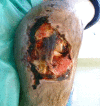Revision Knee Arthroplasty in Patients with Inherited Bleeding Disorders: A Single-Center Experience
- PMID: 28068306
- PMCID: PMC5242200
- DOI: 10.12659/msm.899580
Revision Knee Arthroplasty in Patients with Inherited Bleeding Disorders: A Single-Center Experience
Abstract
BACKGROUND The results of total knee arthroplasty (TKA) in patients with inherited bleeding disorders (IBDs) are poorer when compared with those in the general population, with a notably higher risk of complications and higher revision rates. Thus, revision procedures are becoming a growing concern in this group of patients. The aim of this study was to evaluate the results of revision TKA in patients with IBD. MATERIAL AND METHODS A retrospective cohort study with longitudinal assessment of hemophilia patients scheduled for revision TKA between January 2010 and September 2015 was performed. The clinical status of the patients was assessed based on the Knee Society Score, and the Numeric Rating Scale was used to assess knee pain severity and patient satisfaction with the surgery. Radiological examination, post-operative complications, and reinterventions were recorded and analyzed. RESULTS Very good results were obtained in all patients treated for aseptic loosening of the implant. However, inferior results were found in cases with infection. All patients operated on for aseptic loosening required only single-stage TKA, whereas patients with infection underwent multiple interventions. Complications were observed only in cases with infection. CONCLUSIONS Our study clearly outlined the differences in results based on failure mode, with far inferior results obtained in cases with infection. Given the lack of data in this area as well as the high specificity of this population, further high-quality studies are needed.
Figures



Similar articles
-
Long-term outcomes of primary constrained condylar knee arthroplasty.Orthop Traumatol Surg Res. 2015 Jun;101(4):449-54. doi: 10.1016/j.otsr.2015.01.020. Epub 2015 May 4. Orthop Traumatol Surg Res. 2015. PMID: 25952710
-
Salvage revision total knee replacement using the Endo-Model rotating hinge prosthesis.Knee. 2004 Dec;11(6):469-73. doi: 10.1016/j.knee.2004.03.001. Knee. 2004. PMID: 15581766
-
Long-term results of total knee arthroplasty in haemophilic patients: an 18-year follow-up.Knee Surg Sports Traumatol Arthrosc. 2017 Nov;25(11):3431-3438. doi: 10.1007/s00167-016-4340-6. Epub 2016 Nov 3. Knee Surg Sports Traumatol Arthrosc. 2017. PMID: 27812775
-
Efficacy of Revision Surgery for the Treatment of Stiffness After Total Knee Arthroplasty: A Systematic Review.J Arthroplasty. 2018 Sep;33(9):3049-3055. doi: 10.1016/j.arth.2018.04.036. Epub 2018 Apr 30. J Arthroplasty. 2018. PMID: 29803577
-
Total knee arthroplasty in hemophilia: lessons learned and projections of what's next for hemophilic knee joint health.Expert Rev Hematol. 2022 Jan;15(1):65-82. doi: 10.1080/17474086.2022.2030218. Epub 2022 Jan 24. Expert Rev Hematol. 2022. PMID: 35041571 Review.
Cited by
-
Total knee arthroplasty in hemophilia A.Arthroplast Today. 2020 Mar 6;6(1):52-58.e1. doi: 10.1016/j.artd.2019.12.008. eCollection 2020 Mar. Arthroplast Today. 2020. PMID: 32211475 Free PMC article.
References
-
- Cancienne JM, Werner BC, Browne JA. Complications after TKA in patients with hemophilia or von Willebrand’s disease. J Arthroplasty. 2015;30:2285–89. - PubMed
-
- Rodriguez-Merchan EC. Aspects of current management: orthopaedic surgery in haemophilia. Haemophilia. 2012;18:8–16. - PubMed
-
- World Federation of Hemophilia. WFH Guidelines for Management of Hemophilia. Montreal, Canada: Blackwell Publishing; 2005.
-
- Kotela A, Żbikowski P, Ambrozk P, Kotela I. The Hip: Preservation, Replacement, and Revision. Vol. 2. Brooklandville, MD: DTPC; 2015. Total hip arthroplasty in patients with bleeding disorders.
-
- Żbikowski P, Ambroziak P, Kotela A, Kotela I. Możliwości i perspektywy leczenia ortopedycznego zmian stawowych związanych z wrodzonym niedoborem czynników krzepnięcia. J Tranfusion Med. 2015;8:3–11. [in Polish]
Publication types
MeSH terms
LinkOut - more resources
Full Text Sources
Medical

